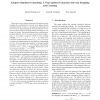Free Online Productivity Tools
i2Speak
i2Symbol
i2OCR
iTex2Img
iWeb2Print
iWeb2Shot
i2Type
iPdf2Split
iPdf2Merge
i2Bopomofo
i2Arabic
i2Style
i2Image
i2PDF
iLatex2Rtf
Sci2ools
110
click to vote
FOCS
2007
IEEE
2007
IEEE
Adaptive Simulated Annealing: A Near-optimal Connection between Sampling and Counting
We present a near-optimal reduction from approximately counting the cardinality of a discrete set to approximately sampling elements of the set. An important application of our work is to approximating the partition function Z of a discrete system, such as the Ising model, matchings or colorings of a graph. The standard approach to estimating the partition function Z(β∗ ) at some desired inverse temperature β∗ is to define a sequence, which we call a cooling schedule, β0 = 0 < β1 < · · · < β = β∗ where Z(0) is trivial to compute and the ratios Z(βi+1)/Z(βi) are easy to estimate by sampling from the distribution corresponding to Z(βi). Previous approaches required a cooling schedule of length O∗ (ln A) where A = Z(0), thereby ensuring that each ratio Z(βi+1)/Z(βi) is bounded. We present a cooling schedule of length = O∗ ( √ ln A). For well-studied problems such as estimating the partition function of the Ising model, or approximating the number of co...
| Added | 02 Jun 2010 |
| Updated | 02 Jun 2010 |
| Type | Conference |
| Year | 2007 |
| Where | FOCS |
| Authors | Daniel Stefankovic, Santosh Vempala, Eric Vigoda |
Comments (0)

